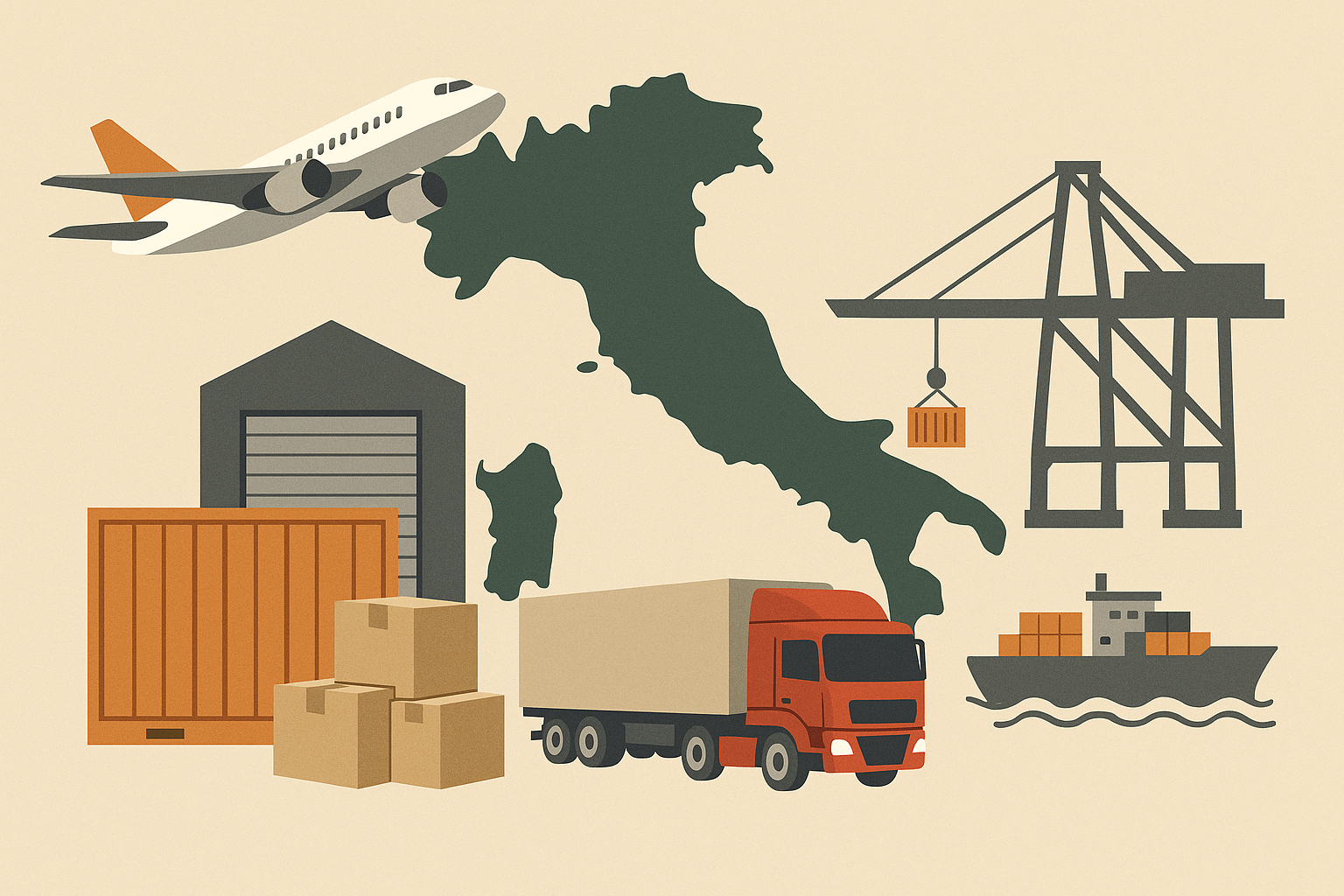Italy’s freight forwarding industry is one of Europe’s largest logistics markets, generating over €85 billion in annual revenue. The country handles more than 500 million tons of cargo each year through its extensive port network, making Italian freight forwarding services essential for international trade.
Italian freight forwarders process approximately 11 million TEU (twenty-foot equivalent units) annually, positioning Italy as Europe’s third-largest container market. This massive cargo volume creates significant economies of scale that benefit businesses shipping through Italian logistics companies.
Furthermore, the freight forwarding Italy market operates through three main hubs: Milan for air freight services, Genoa for ocean freight operations, and Rome for distribution and warehousing. This strategic geographic distribution allows Italian freight forwarders to specialize in specific transportation modes and trade routes. Check if you have understood all the fiscal benefits of this sector.
Table of Contents
ToggleWhat Are The Best Italian Ports for Freight Forwarding?
Building on Italy’s strategic position, the country’s major ports serve as critical gateways for international trade. These ports form the backbone of Italian freight forwarding operations.
Port of Genoa: Italy’s Leading Container Hub
The Port of Genoa processes over 2.6 million TEU annually and connects to more than 120 global destinations. Freight forwarding companies in Genoa benefit from the port’s advanced infrastructure and direct rail connections to major European industrial centers.
Moreover, Genoa freight forwarders handle significant volumes of cargo from Asia, with container services averaging 18-25 day transit times from major Asian ports. This represents a 7-12 day advantage over Northern European alternatives, making Genoa attractive for time-sensitive shipments.
Gioia Tauro: Mediterranean Transshipment Leader
Similarly, Gioia Tauro handles 2.4 million TEU annually as the Mediterranean’s largest transshipment hub. Italian freight forwarding companies use this port primarily for connecting cargo between major shipping lines and smaller regional services.
The port’s strategic location enables efficient distribution to North Africa and Middle East markets, with freight forwarders offering 2-3 day delivery times to over 400 million consumers in these regions.
Port of Trieste: Gateway to Central Europe
Finally, Trieste is the Italy’s main gateway to Central and Eastern European markets. Freight forwarding companies based in Trieste specialize in rail transport, with direct connections to Austria, Hungary, and the Czech Republic.

Italian Freight Forwarding Services and Benefits
Given these strategic port locations, Italian freight forwarders can offer comprehensive logistics solutions across multiple transportation modes. These services are designed to maximize efficiency and cost-effectiveness.
Ocean Freight Forwarding Italy
Italian ocean freight forwarders offer both FCL (Full Container Load) and LCL (Less than Container Load) services with competitive rates due to high cargo volumes. Major shipping lines operate regular services from Italian ports to Asia, providing weekly departures and reliable transit times.
LCL consolidation services achieve 92-95% container utilization rates, creating cost savings of 15-25% compared to FCL for smaller shipments. Italian freight forwarders maintain consolidation centers in major ports, offering weekly departures to 45+ global destinations.
Air Freight Forwarding Services
Meanwhile, Milan serves as Italy’s primary air freight hub, with freight forwarding companies offering direct connections to major global markets. Italian air freight forwarders handle both express and standard air cargo services, with specialized capabilities for temperature-controlled and high-value shipments.
Air freight margins typically range from 12-15% for Italian freight forwarders, with value-added services like customs clearance and documentation generating additional revenue streams.
Road Freight and Trucking Services
In addition to port and air services, Italian road freight forwarders operate extensive trucking networks across Europe, with the ability to reach 85% of EU markets within 48 hours from Italian distribution centers. The country’s road freight sector moves 174 billion ton-kilometers annually.
Intermodal rail-road services offer 35% cost savings compared to road-only transport for distances exceeding 500 km. Italian freight forwarders increasingly use rail connections from major ports to reduce costs and environmental impact.
Italian Customs Clearance and Compliance
Beyond transportation services, effective customs clearance represents a critical component of successful freight forwarding operations. Italian customs procedures follow EU regulations while incorporating specific local requirements.
AEO Certification Benefits
Italian freight forwarders with Authorized Economic Operator (AEO) certification achieve 95% green lane customs clearance rates. This certification allows for faster processing, with shipments cleared in 4-6 hours compared to the industry average of 24-48 hours.
Furthermore, AEO-certified Italian freight forwarding companies offer reduced inspection rates and simplified customs procedures, providing significant time and cost advantages for importers and exporters.
Electronic Customs Processing
Italy processes 78% of customs declarations electronically, above the EU average of 71%. Italian freight forwarders invest in advanced customs systems that integrate with client ERP systems, enabling real-time status updates and automated documentation.
Professional customs clearance services include VAT registration, duty calculation, and compliance management for regulated industries such as pharmaceuticals, food products, and chemicals.
Technology and Innovation in Italian Logistics
Complementing traditional services, Italian freight forwarding companies invest an average of 2.3% of revenue in digital technology upgrades. Leading providers offer API integration, electronic data interchange (EDI), real-time tracking systems, and predictive analytics capabilities.
Advanced transportation management systems (TMS) enable Italian freight forwarders to optimize routes, consolidate shipments, and provide visibility throughout the supply chain. These technology investments improve operational efficiency and customer service quality.
As a result, digital transformation has enabled some Italian freight forwarders to achieve EBITDA margins of 15-18%, compared to traditional operators’ 6-12% margins through improved operational leverage.
If you’re evaluating profitability or tax exposure, you can find and use an income tax calculator to estimate your obligations under Italy’s tax regime.
Specialized Italian Freight Forwarding Services
Beyond standard logistics services, Italian freight forwarders offer specialized solutions for complex cargo requirements. These services address specific industry needs and regulatory requirements.
Temperature-Controlled Logistics
Italian ports handle 2.1 million tons of temperature-controlled cargo annually. Freight forwarding companies offer pharmaceutical-grade storage facilities that meet Good Distribution Practice (GDP) requirements for sensitive healthcare products.
Cold chain logistics services include temperature monitoring, validation documentation, and specialized handling procedures for perishable goods, pharmaceuticals, and chemicals.
Project Cargo and Heavy Lift
Similarly, Italian freight forwarders provide specialized project cargo services with heavy-lift capabilities up to 500 tons. Ports offer specialized ro-ro (roll-on/roll-off) services for oversized equipment and machinery.
Project cargo services include route surveys, permit coordination, specialized packaging, and multimodal transport solutions for construction, energy, and industrial projects.
How to Choose Italian Freight Forwarding Companies
Considering all these service options, selecting the right Italian freight forwarder requires careful evaluation of multiple factors. The following criteria help ensure optimal partner selection.
Financial Stability Indicators
When selecting Italian freight forwarders, evaluate financial metrics including debt-to-equity ratios below 0.4 and current ratios exceeding 1.5. Companies with consistent revenue growth and strong balance sheets provide better service reliability.
Best-performing Italian freight forwarding companies maintain days sales outstanding (DSO) of 45-55 days and achieve inventory turnover rates of 24-30 times annually for contract logistics operations.
Service Quality Metrics
Therefore, look for Italian freight forwarders with on-time performance rates above 95%, cargo damage rates below 0.1%, and customer satisfaction scores exceeding 4.2 out of 5. These metrics indicate operational excellence and service reliability.
Professional certifications including ISO 9001, ISO 14001, and industry association memberships (FIATA, IATA) demonstrate commitment to quality standards and best practices.
Network Coverage and Capabilities
Additionally, choose Italian freight forwarding companies with direct presence in key markets, established agent networks, and multimodal transport capabilities. This ensures seamless service delivery without multiple handoffs that can cause delays or communication issues.
Italian Freight Forwarding Market Trends
Looking ahead, industry consolidation has accelerated since 2020, with over 15 major acquisitions totaling €2.8 billion in deal value. This consolidation creates opportunities for businesses to work with larger, more financially stable Italian freight forwarders.
Moreover, sustainability initiatives are driving investment in rail transport and electric vehicle fleets. Italian freight forwarding companies increasingly offer carbon-neutral shipping options and environmental reporting to meet corporate sustainability requirements.
Finally, the growth of e-commerce continues to drive demand for last-mile delivery services, with Italian freight forwarders expanding distribution networks and same-day delivery capabilities in major urban areas.
Are you interested in with similar topics? Then, take a look at our related articles here; E-commerce: a fiscal guide to the start-up of the activity, Holding Company in EU while Residing in Italy and Should You Invest in Italian Startups?.




